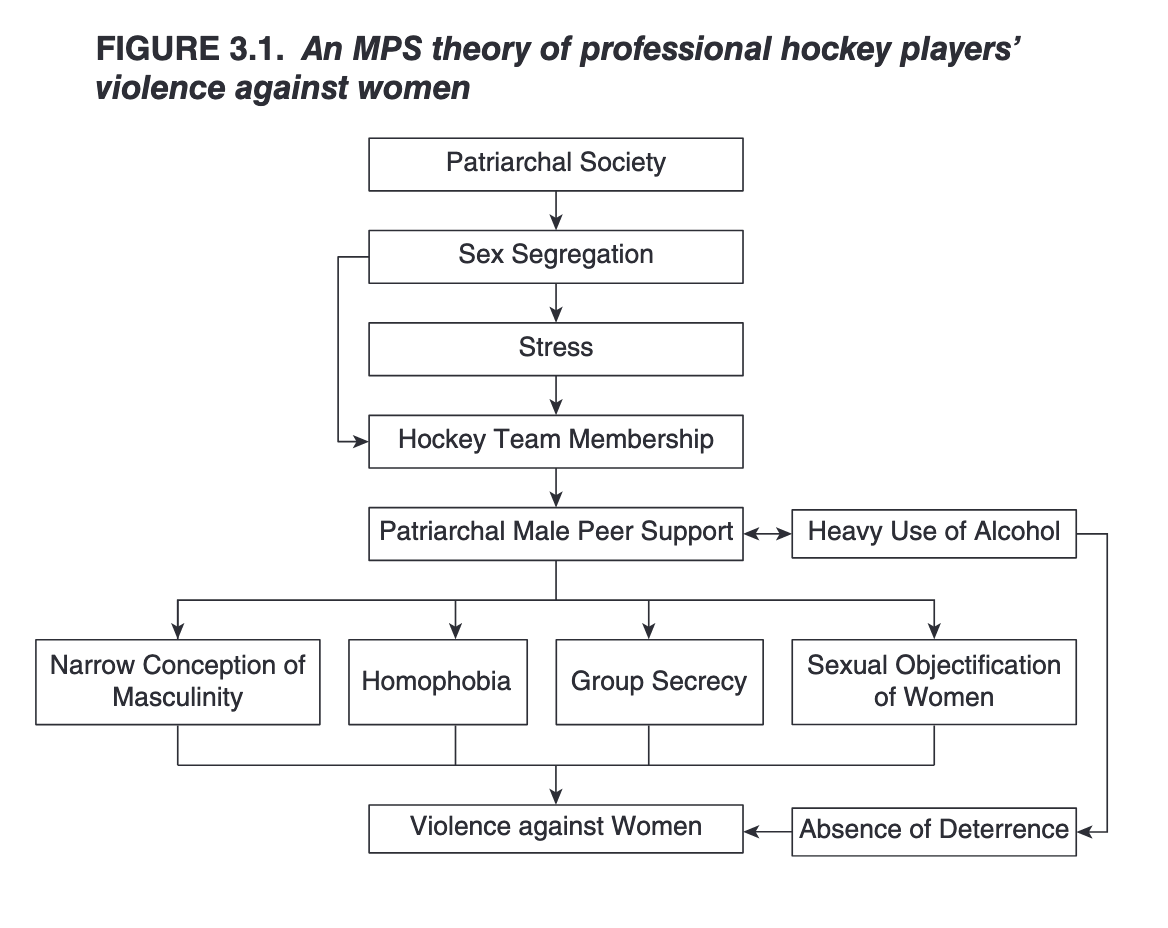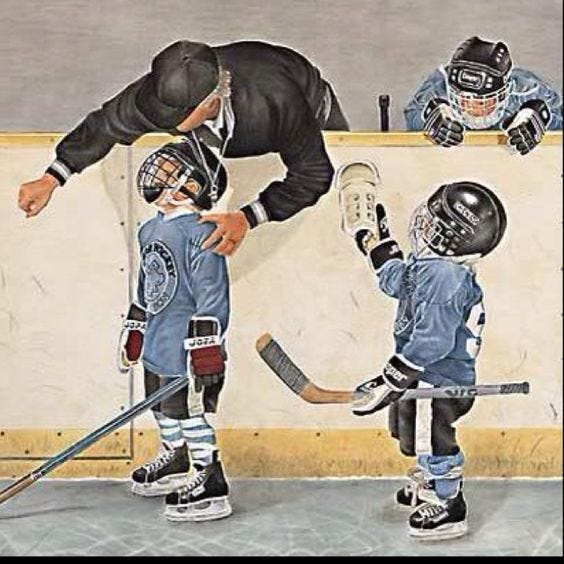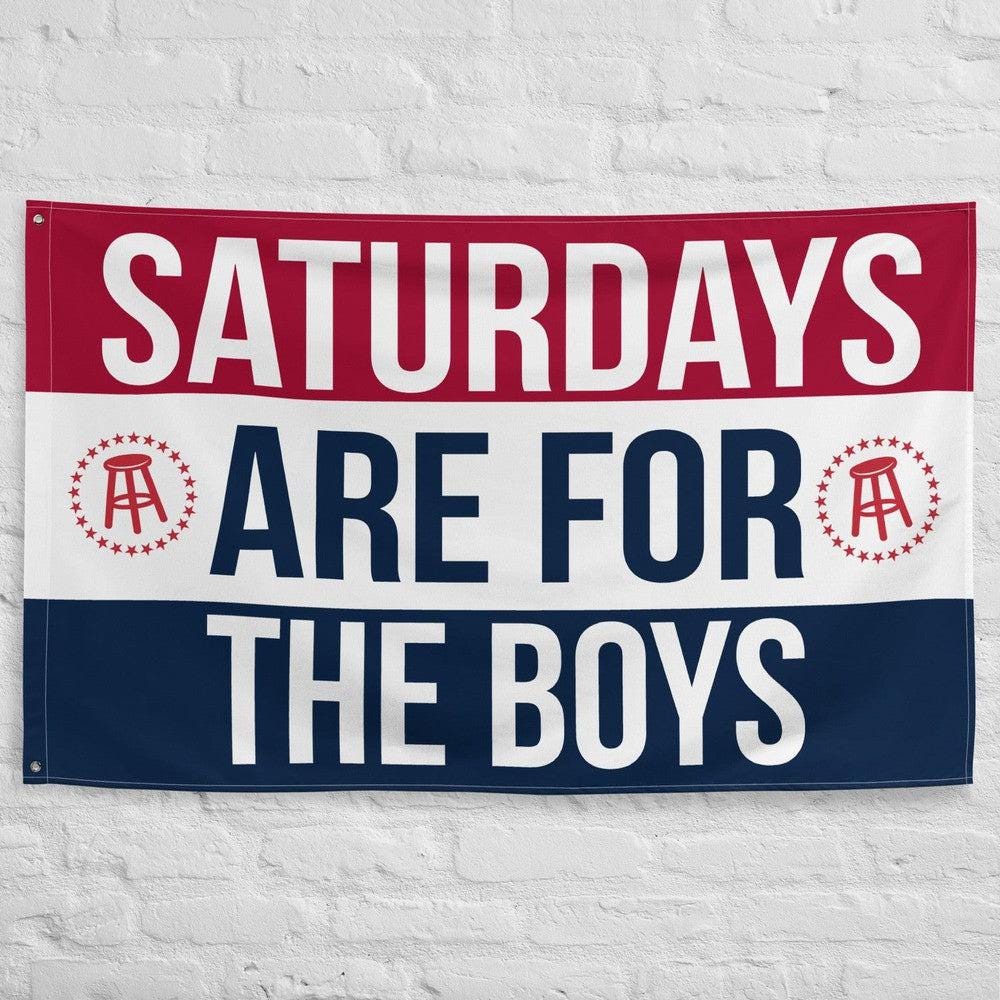008. when the puck drops- The Hockey Canada scandal and the culture we built
In the Penalty Box: Subculture and the Hockey Canada Scandal
The year is 2018, I just wrapped up my first semester of university and was home for the holidays. With nothing better to do than eat copious amounts of panettone and mentally prepare myself for the semester ahead, I decided to watch the World Juniors.
For many, the IIHF World Junior Hockey Championship is appointment television. An annual international hockey championship, first held in 1977. Players (under 20) from ten countries compete for the title and showcase their talent. It has been the stage for career-making performances, where some of the best National Hockey League (NHL) players have been recognized. To this day, Canada has won gold 20 times (more than any other nation), and it's no surprise the team consistently performs well. It is, of course, the country’s national winter sport.
Canada beat Sweden 3-1.
Another championship, another year of bragging rights, another bit of proof that Hockey Canada stands as the Goliath of the sport. A towering institution, armoured in national pride. But even Goliath has a weak spot, and in 2022 it wasn't a slingshot that pierced the armour.
Hockey Canada stands as the Goliath of the sport. A towering institution, armoured in national pride. But even Goliath has a weak spot, and in 2022 it wasn't a slingshot that pierced the armour.
The backstory
TSN journalist Rick Westhead reported in May 2022 that Hockey Canada had settled a lawsuit filed by a woman, alleging she was sexually assaulted after a fundraising gala in London, Ontario, by 8 members of the Canadian World Junior hockey team.1 The report released information that part of the settlement funds was sourced from player registration fees, thus sparking public outcry.
The alleged incident occurred in June 2018, but the investigation was closed in 2019 without any charges being filed. The lawsuit, which was filed in April 2022, led to the reopening of the inquiry in January 2024.2 Flashforward to today, and unless you have been hiding under a rock, you would be hard pressed to find anyone in Canada who has not been following (even loosely) the trial that started in April 2025.
The trial has wrapped up, but the verdict is set to be delivered at the end of July. While the details (and the shambolic series of events known as the judicial proceedings) initially caught my attention, what I consider to be of greater interest is something broader, harder to quantify, but no less palpable: a hockey culture that too often excuses, shields, and at times, glorifies harmful behaviour.
Disappointed does not even begin to describe how I feel when I read comments under news articles about the case, but I can't say I am shocked. Jokes about group sex, accusations of a "money-hungry" accused, and reducing the allegations to "bad judgments" or "a young person’s mistake". Many openly mourned the careers of young men whose talent, in their eyes, outweighs accountability. Everyone has an opinion, which is to be expected, but what is most alarming is that the concern is not the harm that was done, but whether their favourite sport would be inconvenienced.
The logic is familiar: if he can score, we’ll ignore the rest. And that’s not just a problem with a few bad fans but a reflection of the values we’ve built around hockey itself.
I did not come from a hockey family; embarrassingly enough, I never even learned how to skate. However, I grew up in THE hockey town. Brantford, Ontario, is the birthplace of hockey legend Wayne Gretzky, aka 'The Great One'. With roads, sports complexes, tournaments, and even a school sporting the last name. There is no denying both the impact and presence the sport has in the city of just under 110,000 inhabitants. Like most small(er) towns in Canada, hockey is a religion, and players are worshiped like saints.
But I think this gave me a unique perspective on hockey culture. I observed how deeply embedded it was into the lives of those around me, but never really being involved myself. Always in proximity but never immersed. Watching from the bench but never making it onto the ice.
Power plays and privilege
Even before the term ‘rape culture’ entered my vocabulary, I saw evidence of what has been described by sociologist Michael Kimmel as aggrieved entitlement. It refers to “the sense that one has been wronged or denied something that is rightfully theirs, leading to anger and attempts to reassert dominance”.3 With a culture built on winning, toughness, and male dominance, these values can normalize aggressive behaviour. This entitlement does not just exist on the individual level, but also with coaches and parents who are heavily invested, financially and emotionally, in the development of the player.
The term “hockey dad,” used to describe a father heavily involved in his child’s ice hockey experience, was generally seen as positive. However, the meaning has shifted; I have heard people use it to describe parents who place an intense amount of pressure on their children, prioritize success over values, and vicariously live their elite sport dreams through their child. These secondary members of the hockey community subtly reinforce entitlement, such as minimizing harmful behaviour and prioritizing performance over empathy. I have seen firsthand how this shapes the behaviours of the peers around me, impacts friendships, and also behaviour in adulthood.
Elements of hockey culture, such as the “hockey dad,” were something I always observed but never had the displeasure of experiencing. Beyond that, I witnessed the entitlement in action. Growing up, it was not uncommon for different rules to apply to different people because of their athletic prowess. At its best, it’s simply favouritism; at its worst, those in power turned a blind eye to harmful behaviour such as bullying and sexual harassment. When it came to sexual harassment, I thought the answer was as simple as chalking it up to the patriarchy. However, what I consistently missed is the social dynamic of the sport, its impact on behaviour, and how it is learned.
The book titled Skating on Thin Ice: Professional Hockey, Rape Culture & Violence Against Women4 discusses male peer support theory (MPS). MPS ironically has deep roots in Canada, as it was first developed by PhD student Walter DeKeseredy at York University.5 The theory emphasizes that men’s violence against women is also shaped by the specific social and relational settings in which these men move, not just focusing on patriarchal society as a whole.6 The attachment to male peer groups that perpetually reinforce standards of gratification through dominance encourages other men to engage in this behaviour.

Sex-segregated
According to Laura Robinson, hockey is a sex-segregated environment where men spend most of their time in all-male spaces.7 Locker rooms, buses, Delta Hotels, and private team activities are all spaces where women’s voices are lacking and harmful views of masculinity are encouraged. A former college athlete expressed in a 2004 research interview when discussing his teammates,
“They treat women like objects – sexual objects. They talk about them as if they aren’t there, as if [the athletes] were in the locker room talking ... and don’t care what they say at all because they think they’re still going to have sex or whatever. Things like that machismo group mentality, that locker room mentality, come out in off-ice behaviour... treating women really bad ... like one-nighters or short-term girlfriends or someone they didn’t care very much, just as objects or sex partners.”8
Reading this quote makes me wonder, how many of these conversations are had at my local ice rink or high school locker room? This mentality mirrors evidence in the 2018 Hockey Canada scandal, the group’s behaviour displays peer-enforced masculinity where sexual conquest becomes a performance of manhood and acceptance/validation by the group.
Looking at language
Despite never playing hockey, the lingo has inevitably leaked into my vocabulary (and the vocabulary of greater Canadian culture). Like any subculture, what you wear, how you style your hair, and how you talk shape the identity of who is “in” and who is “out”. Words like “chirp” for trash talk, “the Show” to describe the NHL, and “beaut” to describe a great player/person are all a part of the Canadian lexicon. But there is also evidence of pervasive misogynist language. The term “puck bunnies” describes women who are not authentically dedicated to the game but are only interested in having sex with players.9 This kind of lingo, coupled with “locker room talk,” serves as a kind of bonding ritual to build group solidarity and trivialize violence against women.
the “Sauce”
Another large part of the subculture is the presence of alcohol. Keeping on the topic of language, alcohol is often referred to as “the Sauce”. Alcohol was a player in the events that transpired in London, Ontario; a major point for both the prosecution and defence in the trial. It is a staple in male social networks10 , and researchers who specialize in MPS found that alcohol abuse is a major factor in peer group processes related to violence against women.11 It is often used in all-male social contexts that support patriarchal conversations about women’s sexuality and how to control it. Throughout the decades, many NHL teams have been faced with scandals of players abusing women, with alcohol being a factor (Milan Lucic, Semyon Varlamov, and Slava Voynov, just to name a few).
It’s not uncommon in towns with OHL teams (a major junior ice hockey league in the province of Ontario) that players are praised, drinks are ‘on the house,’ and they become minor celebrities. Initially, most would take no issue with that. These players have achieved a great opportunity, one step closer to their dream. On the other hand, it is an example of what underlines the nature of hockey culture and its relationship with alcohol. Women are usually excluded from these social events, and some argue that female exclusion fuels subculture solidarity.12
Alcohol as a part of the subculture sparks a memory from my first few years of uni. “Saturday is for the Boys,” or “ferda” for short, is a phrase commonly used by players and fans in the subculture. The latter, popularized by the TV show Letterkenny and the former being trademarked by Barstool Sports. I recall it was plastered all over dorm rooms, hats, t-shirts, and stickers on laptops in my 9 a.m. sociology lecture (oh the irony). This is a perfect summarization of subculture language, drinking culture, and the absence of women, all the factors of MPS examining hockey culture.
Your secret is safe with me
Lastly, peer loyalty and secrecy in the hockey world could be the largest issue to tackle. Why is secrecy so important? Well, because “group secrecy keeps men from revealing the deviant behaviour of their teammates to ‘outsiders.’13
This can be seen directly in the events of the evening in London, Ontario. Witnesses were called to the stand to testify as to why they did not participate in the events, if they told anyone or why they kept it a secret. This secrecy is a part of the patriarchal male culture of protection, and a code of silence is seen as a form of team loyalty. It’s intended to protect not only your teammates as friends, but also on an institutional level, to protect an investment. Protecting the financial interests of the individual and the teams they work for may come at the cost of doing the right thing.
In the Hockey Canada scandal, group chat text messages reveal secrecy and collaboration in action, with one message reading, “We all need to say the same thing if we get interviewed,” “Can’t have different stories or make anything up.”14 It is important to note that this text message was not admitted into evidence. I could write a whole paper on the problems of the trial, starting with just the jury dismissal or how I think it was a prime example of over-lawyering. However, what is not disputed is that the message was sent, and from a sociological perspective, it provides evidence of the importance of group alliance.
Breakaway culture
Since 1989, Hockey Canada has settled twenty-one sexual misconduct claims, totalling CAD$8.9 million. Nine of the victims were paid through Hockey Canada’s National Equity Fund, which is partially funded by membership fees paid by the families of children entering the sport.15 The Montreal Gazette reported that the victim of the alleged 2018 gang sexual assault, settled for “[CAD]$3.55-million lawsuit and buy her silence on behalf of her assailants”.16 A small price to pay when the organization is worth $98.5 million as of June 2022.17
However, it is my hope that hockey is amid a reckoning, a TSN Turning Point if you will… and it is much needed. In a sport seen as imparting positive values like hard work, teamwork, and dedication, I would like to see some of those values reflected in remedying the issue of violence against women and a system that encourages it. Defenders of hockey culture argue that these scandals are caused by a “few bad apples” rather than the sport itself, pointing to the positive values of the sport. While these values exist, MPS theory reveals that the same peer bonds that create team unity can also enforce silence and protect harmful behaviour. The Hockey Canada case demonstrates that when loyalty is prioritized over accountability, the entire culture bears responsibility. Hockey is not just a sport; it’s a social institution that holds a mirror to Canadian society and what we choose to tolerate.
These are discussions that have been had across the pond when it comes to football/soccer culture, but maybe we Canadians are a bit too “polite” to admit that similar problems come with our beloved pastime. Maybe after this case, hockey’s bubble has officially “popped”, although I admittedly said the same thing after Don Cherry’s fall from grace.
No matter what the verdict is (frankly, I am losing faith in the justice system by the day), you cannot deny that this case sheds light on a deeper systemic issue within hockey culture. It comes as no surprise to me that some people reading this will jump to defend the sports culture, and to that I say, I think they are precisely the problem. Because, unlike them, I won’t accept this as "just a part of the game”.
CTV News. “CTV National News: Latest on Hockey Canada.” CTV News, accessed July 18, 2025. https://www.ctvnews.ca/video/c2487595-ctv-national-news--latest-on-hockey-canada/.
CBC News. “Recap: After 8 Weeks, Hockey Canada Sex Assault Trial Ends and Fates of Accused Ex-Players Rest with Judge.” CBC News, March 2025. https://www.cbc.ca/news/canada/london/livestory/recap-after-8-weeks-hockey-canada-sex-assault-trial-ends-and-fates-of-accused-ex-players-rest-with-judge-9.6796534.
Michael S. Kimmel, Angry White Men: American Masculinity at the End of an Era (New York: Nation Books, 2013), 45.
Walter S. DeKeseredy, Ian G. Cowan, and Martin D. Schwartz, Skating on Thin Ice: Professional Hockey, Rape Culture, and Violence Against Women (Toronto: University of Toronto Press, 2023).
Ibid at 116.
Ibid.
Laura Robinson, “Hockey Night in Canada,” in Sexual Assault in Canada: Law, Legal Practice and Women’s Activism, ed. Elizabeth A. Sheehy (Ottawa: University of Ottawa Press, 2012), 73–86.
Nick T. Pappas, Patrick C. McKenry, and Beth Skilken Catlett, “Athlete Aggression on the Rink and off the Ice: Athlete Violence and Aggression in Hockey and Interpersonal Relationships,” Men and Masculinities 6, no. 3 (2004): 291–312
Supra note 3 at 120.
Ibid at 129.
Ibid.
Ibid at 131.
Ibid at 133.
Katie Strang, “Hockey Canada Sexual Assault Trial: Player Texts Revealed,” The New York Times Athletic, May 15, 2025, https://www.nytimes.com/athletic/6359509/2025/05/15/hockey-canada-sexual-assault-trial-player-texts/.
Kieran Leavitt, “21 Victims. $8.9M in Compensation. Hockey Canada Reveals Its History of Settling Sexual Misconduct Claims,” Toronto Star, July 27, 2022, https://www.thestar.com/news/canada/2022/07/27 /hockey-canada-scandal-president-former-ceo-to-appear-before -committee.html.
Jack Todd, “Change at Hockey Canada Needs to Come at the Top,” Montreal Gazette, July 25, 2022, https://montrealgazette.com /sports/hockey/nhl/hockey-inside-out/jack-todd-change-at-hockey -canada-needs-to-come-at-the-top.
Charity Intelligence Canada. “The Rest of the Story.” Charity Intelligence Canada, accessed July 18, 2025. https://www.charityintelligence.ca/research-and-news/ci-views/43-charity-news/734-the-rest-of-the-story.




